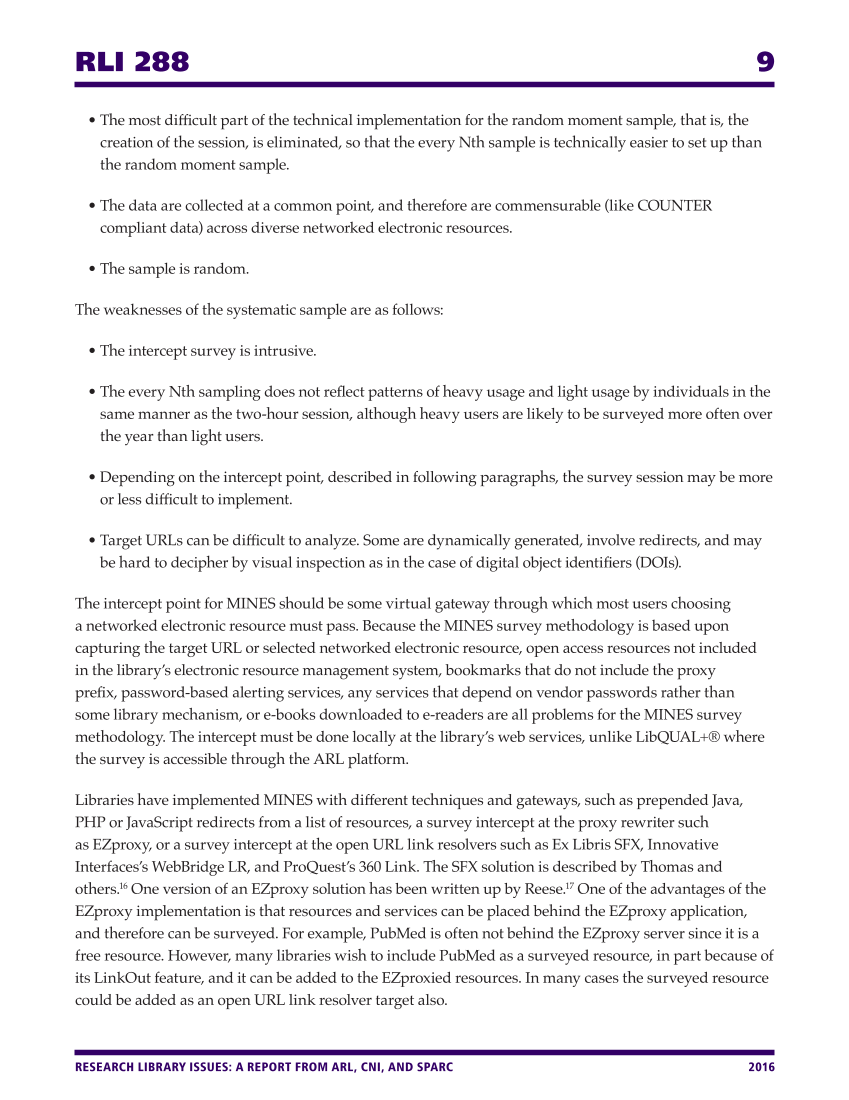RLI 288 9 RESEARCH LIBRARY ISSUES: A REPORT FROM ARL, CNI, AND SPARC 2016 • The most difficult part of the technical implementation for the random moment sample, that is, the creation of the session, is eliminated, so that the every Nth sample is technically easier to set up than the random moment sample. • The data are collected at a common point, and therefore are commensurable (like COUNTER compliant data) across diverse networked electronic resources. • The sample is random. The weaknesses of the systematic sample are as follows: • The intercept survey is intrusive. • The every Nth sampling does not reflect patterns of heavy usage and light usage by individuals in the same manner as the two-hour session, although heavy users are likely to be surveyed more often over the year than light users. • Depending on the intercept point, described in following paragraphs, the survey session may be more or less difficult to implement. • Target URLs can be difficult to analyze. Some are dynamically generated, involve redirects, and may be hard to decipher by visual inspection as in the case of digital object identifiers (DOIs). The intercept point for MINES should be some virtual gateway through which most users choosing a networked electronic resource must pass. Because the MINES survey methodology is based upon capturing the target URL or selected networked electronic resource, open access resources not included in the library’s electronic resource management system, bookmarks that do not include the proxy prefix, password-based alerting services, any services that depend on vendor passwords rather than some library mechanism, or e-books downloaded to e-readers are all problems for the MINES survey methodology. The intercept must be done locally at the library’s web services, unlike LibQUAL+® where the survey is accessible through the ARL platform. Libraries have implemented MINES with different techniques and gateways, such as prepended Java, PHP or JavaScript redirects from a list of resources, a survey intercept at the proxy rewriter such as EZproxy, or a survey intercept at the open URL link resolvers such as Ex Libris SFX, Innovative Interfaces’s WebBridge LR, and ProQuest’s 360 Link. The SFX solution is described by Thomas and others.16 One version of an EZproxy solution has been written up by Reese.17 One of the advantages of the EZproxy implementation is that resources and services can be placed behind the EZproxy application, and therefore can be surveyed. For example, PubMed is often not behind the EZproxy server since it is a free resource. However, many libraries wish to include PubMed as a surveyed resource, in part because of its LinkOut feature, and it can be added to the EZproxied resources. In many cases the surveyed resource could be added as an open URL link resolver target also.





































